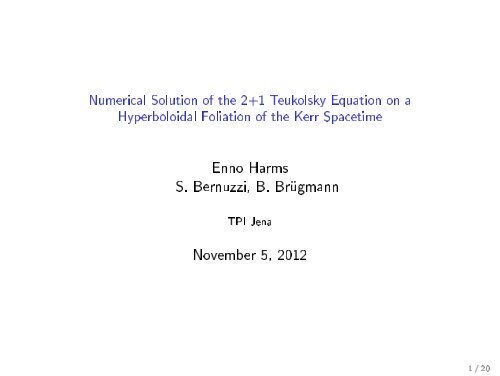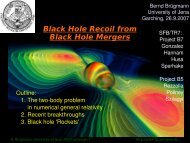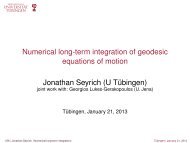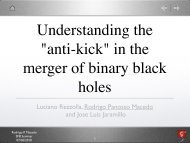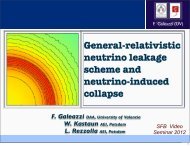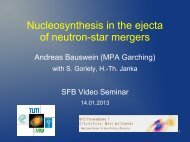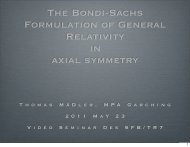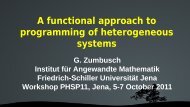Numerical solution of the 2+1 Teukolsky equation on a ...
Numerical solution of the 2+1 Teukolsky equation on a ...
Numerical solution of the 2+1 Teukolsky equation on a ...
Create successful ePaper yourself
Turn your PDF publications into a flip-book with our unique Google optimized e-Paper software.
<str<strong>on</strong>g>Numerical</str<strong>on</strong>g> Soluti<strong>on</strong> <str<strong>on</strong>g>of</str<strong>on</strong>g> <str<strong>on</strong>g>the</str<strong>on</strong>g> <str<strong>on</strong>g>2+1</str<strong>on</strong>g> <str<strong>on</strong>g>Teukolsky</str<strong>on</strong>g> Equati<strong>on</strong> <strong>on</strong> aHyperboloidal Foliati<strong>on</strong> <str<strong>on</strong>g>of</str<strong>on</strong>g> <str<strong>on</strong>g>the</str<strong>on</strong>g> Kerr SpacetimeEnno HarmsS. Bernuzzi, B. BrügmannTPI JenaNovember 5, 20121 / 20
Goal· accurate numerical <str<strong>on</strong>g>soluti<strong>on</strong></str<strong>on</strong>g> <str<strong>on</strong>g>of</str<strong>on</strong>g> <str<strong>on</strong>g>the</str<strong>on</strong>g> <str<strong>on</strong>g>Teukolsky</str<strong>on</strong>g> Equati<strong>on</strong> in <str<strong>on</strong>g>the</str<strong>on</strong>g>time domain· applicati<strong>on</strong> <strong>on</strong> <str<strong>on</strong>g>the</str<strong>on</strong>g> late time decay (tails) <str<strong>on</strong>g>of</str<strong>on</strong>g> generic spin weightperturbati<strong>on</strong>sStructure <str<strong>on</strong>g>of</str<strong>on</strong>g> <str<strong>on</strong>g>the</str<strong>on</strong>g> Talk1. The <str<strong>on</strong>g>Teukolsky</str<strong>on</strong>g> Equati<strong>on</strong>2. The Hyperboloidal Approach3. Pseudo-Spectral and FD-Evoluti<strong>on</strong>-Codes4. <str<strong>on</strong>g>Numerical</str<strong>on</strong>g> Experiments5. C<strong>on</strong>clusi<strong>on</strong>2 / 20
The <str<strong>on</strong>g>Teukolsky</str<strong>on</strong>g> Equati<strong>on</strong>, hereafter TKEq, [<str<strong>on</strong>g>Teukolsky</str<strong>on</strong>g>, 1973]· derived originally in Boyer-Lindquist coordinates· describes <str<strong>on</strong>g>the</str<strong>on</strong>g> evoluti<strong>on</strong> <str<strong>on</strong>g>of</str<strong>on</strong>g> linear perturbati<strong>on</strong>s <str<strong>on</strong>g>of</str<strong>on</strong>g> a rotatingblack hole (Kerr BH with mass M, spec. angular momentum a)· a wavelike <str<strong>on</strong>g>equati<strong>on</strong></str<strong>on</strong>g> for <str<strong>on</strong>g>the</str<strong>on</strong>g> eld variable ΨType <str<strong>on</strong>g>of</str<strong>on</strong>g> perturbati<strong>on</strong> depends <strong>on</strong> spin weight parameter s· Ψ refers to dierent elds depending <strong>on</strong> s,e.g. for s = −2 it is Ψ = (r − i cos θ) 4 · Ψ 4· for s = 0 <str<strong>on</strong>g>the</str<strong>on</strong>g> TKEq is just <str<strong>on</strong>g>the</str<strong>on</strong>g> 3D scalar wave <str<strong>on</strong>g>equati<strong>on</strong></str<strong>on</strong>g> <strong>on</strong>Kerr□Ψ = 03 / 20
Our Approach· transform TKEq to Kerr-ingoing coors and apply hyperboloidalcompacticati<strong>on</strong>τ = T + h(R)r =RΩ(R)· h height functi<strong>on</strong>, Ω compress functi<strong>on</strong>· we follow [Rácz, Tóth, 2011] (RT) choices for h and Ω⇒ smooth, horiz<strong>on</strong>-penetrating, hyperboloidal foliati<strong>on</strong> <str<strong>on</strong>g>of</str<strong>on</strong>g> Kerr i 0 i 0 Figure: C<strong>on</strong>formal SS diagram. τ -slices as blue, RT-slices as green solid lines.4 / 20
Coordinate Speeds in RT-Foliati<strong>on</strong>Ingoing and Outgoing coordinate speeds0.100.05M= 1, a = 0R 0.618c Rc±R0.000.05c R0.100.65 0.70 0.75 0.80 0.85 0.90 0.95 1.00R· coordinate speeds vanish at R + respectively J +⇒ no boundary c<strong>on</strong>diti<strong>on</strong>s needed5 / 20
TKEq <strong>on</strong> RT-Foliati<strong>on</strong>The eld variable needs rescaling· RT rescaling: Ψ → r −1 Ψ· enough for s = 0, but singular at R + for s ≠ 0⇒ simple proposal:· where ∆ = r 2 − 2Mr + a 2Ψ → ∆ −s · r −1 Ψ· this rescaling yields a new formulati<strong>on</strong> <str<strong>on</strong>g>of</str<strong>on</strong>g> <str<strong>on</strong>g>the</str<strong>on</strong>g> TKEq, which isregular over <str<strong>on</strong>g>the</str<strong>on</strong>g> whole domain [R + , J + ]6 / 20
Implementati<strong>on</strong>Pseudo-spectral-evoluti<strong>on</strong>-code = PS-code· Method <str<strong>on</strong>g>of</str<strong>on</strong>g> Lines, RK4-time integrator· derivative approximati<strong>on</strong> by· Chebyshev in radial directi<strong>on</strong> (Gauss-Lobatto-grid)· Fourier in angular directi<strong>on</strong> (staggered grid)· quadruple-precisi<strong>on</strong> possibleFinite-dierencing-evoluti<strong>on</strong>-code = FD-code· basically <str<strong>on</strong>g>the</str<strong>on</strong>g> same but:· equidistant grid in radial directi<strong>on</strong>· derivatives with FD stencils(up to 6th order, lop-sided near and sided at boundaries)(Note: exploiting axisymmetry we implemented <str<strong>on</strong>g>the</str<strong>on</strong>g> TKEq in 2 + 1 )7 / 20
Initial Data - ID0, ID1, ID2, ID3· combinati<strong>on</strong>s <str<strong>on</strong>g>of</str<strong>on</strong>g> (n<strong>on</strong>)-stati<strong>on</strong>ary with (n<strong>on</strong>)-compact ID{ψ(0, R) = G(R) / 1ID0 / ID2 :∂ T ψ(0, R) = 0{ψ(0, R) = 0ID1 / ID3 :∂ T ψ(0, R) = G(R) / 1with G(R) = e − w 2 (R−R 0) 2· in angular directi<strong>on</strong> we set a pure multipole s Y ml ′ (θ)(Note: <str<strong>on</strong>g>the</str<strong>on</strong>g> terms stati<strong>on</strong>ary and compact are used here following <str<strong>on</strong>g>the</str<strong>on</strong>g> literaturethough not rigorously appropriate)8 / 20
Qualitative Evoluti<strong>on</strong> <str<strong>on</strong>g>of</str<strong>on</strong>g> Perturbati<strong>on</strong>s0-2ID0, s=-2, a=0.0, l′=2 , at θ=1.5708Log 10 |Ψ|-4-6-8-10-12Three phases-140 100 200 300 400 500 600 700T/MRH=0.6180R1=0.6740R2=0.7313· initial burst phaseR3=0.8290R4=0.9045R5=0.9635R6=0.9835R7=0.9907R8=0.9976R9=0.9990RS=1.0000· quasi-normal-ringing (=QNR) phase , Ψ ∝ e i ω t· power-law tail phase , Ψ ∝ t −µ 9 / 20
Mixing <str<strong>on</strong>g>of</str<strong>on</strong>g> Modes <strong>on</strong> Kerr· <strong>on</strong> SS initial pure multipole l ′ stays pure⇒ investigate decay µ <str<strong>on</strong>g>of</str<strong>on</strong>g> full eld ψ· <strong>on</strong> Kerr l ′ excites o<str<strong>on</strong>g>the</str<strong>on</strong>g>r modes l⇒ investigate decay µ l <str<strong>on</strong>g>of</str<strong>on</strong>g> modes ψ m lID0, s=-2, a=0.0, l′=2, at R=0.9045ID0, s=-2, a=0.9, l′=2, at R=0.974000-5-5-10-10Log 10 |Ψ slm |-15-20Log 10 |Ψ slm |-15-20-25-25-30-30-350 0.5 1 1.5 2 2.5 3LogTLog|Ψ −220 | Log|Ψ −230 | Log|Ψ −240 | Log|Ψ −250 |-350 0.5 1 1.5 2 2.5 3LogTLog|Ψ −220 | Log|Ψ −230 | Log|Ψ −240 | Log|Ψ −250 |(note: in m <str<strong>on</strong>g>the</str<strong>on</strong>g> modes are still decoupled <strong>on</strong> Kerr)10 / 20
<str<strong>on</strong>g>Numerical</str<strong>on</strong>g> Experiments - s = 0, a = 0-2.5ID0, s=0, a=0.0, l′=1, θ=1.2716-3-3.5µ-4-4.5-5-5.5400 600 800 1000 1200 1400 1600T/MRH=0.6180R1=0.9070R2=0.9635R3=0.9811R4=0.9907R5=0.9952R6=0.9969R7=0.9983R8=0.9992R9=0.9998RS=1.0000Figure: The plot shows <str<strong>on</strong>g>the</str<strong>on</strong>g> local power index (LPI) µ at dierent extracti<strong>on</strong>radii for l ′ = 1 <strong>on</strong> SS.· splitting in space :µ splits into two distinct values at i + |J +· µ = 5|3 ts to <str<strong>on</strong>g>the</str<strong>on</strong>g> predicti<strong>on</strong>s 2 l ′ + 3|l ′ + 2by [Price, 1972], [Gundlach et al., 1994]11 / 20
<str<strong>on</strong>g>Numerical</str<strong>on</strong>g> Experiments - s= 0, a = 0.9, for ID1l ′ l = 0 l = 1 l = 2 l = 3 l = 4 l = 50 3|2 − 5|4 − 7|6 −1 − 5|3 − 7|5 − (9)|72 3|2 − 5|4 − 7|6 −3 − 5|3 − ×|5 − ×|74 5|4 − (7)|4 − ×|6 −5 − 7|5 − (9)|5 − ×|7· agree with RT (, see also [Zengino§lu,Khanna,Burko,2012])· l ≥ l ′ up-modes· l < l ′ down-modes12 / 20
<str<strong>on</strong>g>Numerical</str<strong>on</strong>g> Experiments - LPI split for s = −2· in up-modes µ <str<strong>on</strong>g>of</str<strong>on</strong>g> far out observers can split (in time):⇒ at early times a dierent LPI than at late times0ID1, s=-2, a=0.9, l′=4-2-4-6µ 4-8-10-12-14600 700 800 900 1000 1100 1200 1300T/MRH=0.5222R1=0.8550R2=0.9183R3=0.9479R4=0.9605R5=0.9662R6=0.9715R7=0.9808R8=0.9883R9=0.9962⇒ departing from R = 1 to R = R + observers see <str<strong>on</strong>g>the</str<strong>on</strong>g> asymptoticLPI µ 4 = 9 gradually earlier13 / 20
<str<strong>on</strong>g>Numerical</str<strong>on</strong>g> Experiments - LPI split in space for s = +2· for special case s > 0, m > 0 [Hod, 1999], [Barack, Ori, 1999]:⇒ LPI splits into three distinct values at R + |R + < R < J + |J +µ 3-2-3-4-5-6-7-8-9ID0, s=2, a=0.9, l′=2600 700 800 900 1000 1100 1200T/MRH=0.5222R1=0.5270R2=0.5317R3=0.5365R4=0.5461R5=0.6225R6=0.9713R7=0.9857R8=0.9904R9=0.9952RS=1.0000· distinct positi<strong>on</strong> R + < ˜R < J+ sees asymptotic decay rateearliest ⇒ here: ˜R ≈ 0.6225· smooth transiti<strong>on</strong> from decay at R + to ˜R(note: for s = 1 dierent but also smooth transiti<strong>on</strong>)14 / 20
<str<strong>on</strong>g>Numerical</str<strong>on</strong>g> Experiments - C<strong>on</strong>vergence· s = −2, a = 0.9, l ′ = 2, ID0Log 10 ckLog 10 ck051015202530T⩵0.350 20 40 60 80 100 120k051015202530T⩵409.338350 20 40 60 80 100 120kLog 10 ckLog 10 ck051015202530T⩵49.1205350 20 40 60 80 100 120k051015202530T⩵1473.62350 20 40 60 80 100 120k15 / 20
<str<strong>on</strong>g>Numerical</str<strong>on</strong>g> Experiments - C<strong>on</strong>vergence· s = −2, a = 0.9, l ′ = 2, ID0Log 10 ckLog 10 ck051015202530T⩵0.350 20 40 60 80 100k051015202530T⩵409.338350 20 40 60 80 100kLog 10 ckLog 10 ck051015202530T⩵49.1205350 20 40 60 80 100k051015202530T⩵1473.62350 20 40 60 80 100k· at late times <str<strong>on</strong>g>soluti<strong>on</strong></str<strong>on</strong>g> can be described by few modes16 / 20
C<strong>on</strong>clusi<strong>on</strong> - Formulas for s ≠ 0 with ID0 and ID2· at R + :{µ l =l 0 + l + 3 + b −1 for l ′ = l 0 , l 0 + 1l ′ + l + 2 + b −1 for l ′ > l 0 + 1· at ˜R:{µ l =l 0 + l + 3 −1 for l ′ = l 0 , l 0 + 1l ′ + l + 2 −1 for l ′ > l 0 + 1· at J + :⎧⎨ l − s + 2 −1 for l ′ = l 0 , l 0 + 1µ l = l ′ − s + 1 −1⎩l − s + 2 −1for l ′ > l 0 + 1 and l < l ′for l ′ > l 0 + 1 and l ≥ l ′, where l 0 = max(|s|, |m|) is <str<strong>on</strong>g>the</str<strong>on</strong>g> lowest excitable modeand b = 0 in general but b = 1 for <str<strong>on</strong>g>the</str<strong>on</strong>g> special case s > 0, m = 017 / 20
C<strong>on</strong>clusi<strong>on</strong> - Formulas for s ≠ 0 with ID1 and ID3· at R + :⎧⎨ l 0 + l + 3 + b −1 for l ′ = l 0µ l = l 0 + l + 4 + b −1 for l ′ = l 0 + 1⎩l ′ + l + 1 + b −1 for l ′ > l 0 + 1⎧⎨ l 0 + l + 3 −1 for l ′ = l 0· at ˜R:µ l = l 0 + l + 4 −1⎩l ′ + l + 1 −1for l ′ = l 0 + 1for l ′ > l 0 + 1· at J + :⎧l − s + 2 −1 for l ′ = l 0⎪⎨ l − s + 3 −1 for l ′ = l 0 + 1 and l = l 0µ l = l − s + 2 −1 for l ′ = l 0 + 1 and l > l 0l⎪⎩′ − s −1 for l ′ > l 0 + 1 and l < l ′ − 1l − s + 2 −1 for l ′ > l 0 + 1 and l ≥ l ′ − 1⇒ same decrement by 1 as for switch ID0 → ID218 / 20
C<strong>on</strong>clusi<strong>on</strong>· new formulati<strong>on</strong> <str<strong>on</strong>g>of</str<strong>on</strong>g> <str<strong>on</strong>g>the</str<strong>on</strong>g> TKEq in RT-foliati<strong>on</strong>, which is regularover <str<strong>on</strong>g>the</str<strong>on</strong>g> whole domain, including R + and J +· c<strong>on</strong>rmati<strong>on</strong> <str<strong>on</strong>g>of</str<strong>on</strong>g> decay rates µ l <str<strong>on</strong>g>of</str<strong>on</strong>g> [RT, 2011] for s = 0· empirical formulas for µ l for s ≠ 0 with ID0,ID1,ID2,ID3· rst num. vericati<strong>on</strong> <str<strong>on</strong>g>of</str<strong>on</strong>g> LPI-split in space for s > 0, m = 0· discovered splitting <str<strong>on</strong>g>of</str<strong>on</strong>g> LPI in time for s ≠ 0Outlook· up to now <strong>on</strong>ly axisymmetric initial data m = 0,(superradiance experiments)· particle perturbati<strong>on</strong>19 / 20
(A small selecti<strong>on</strong> <str<strong>on</strong>g>of</str<strong>on</strong>g>) References1. <str<strong>on</strong>g>Teukolsky</str<strong>on</strong>g>, 19722. Price, 19723. Gundlach, Price, Pullin 19944. Krivan, Laguna, Papadopolous, 1996, 19975. Barack, Ori, 19996. Hod, 1999, 20007. Burko, Khanna, 2003, 2009, 20118. Bizo«, 20099. Zengino§lu, 2009, 201110. Zengino§lu, Nunez, Husa, 200911. Rácz, Tóth, 201112. Jasiulek, 201213. Zengino§lu, Khanna, Burko 201214. E.Harms, Master Thesis, 201215. E.Harms, S.Bernuzzi [in preparati<strong>on</strong>]20 / 20


